In this interview, we sit down with Ben Torres, Vice President of Operations at The Vintage Whiskey and Cigar Bar, to explore the vision and passion ...
How Samantha Kuczynski Revives Vintage Furniture with Stuffed & Tufted
Written by: Esther Strauss
Esther is a business strategist with over 20 years of experience as an entrepreneur, executive, educator, and management advisor.
Published on August 19, 2024

In this interview, we speak with Samantha Kuczynski, the talented owner and upholsterer behind Stuffed & Tufted, a Baltimore-based custom upholstery business. Samantha shares her journey from honing her craft to running a successful business that breathes new life into old furniture. With a focus on sustainability and craftsmanship, Samantha’s approach to upholstery is not just about repair, but about preserving the stories and memories embedded in each piece. Her insights are invaluable for aspiring entrepreneurs and those interested in the art of upholstery.
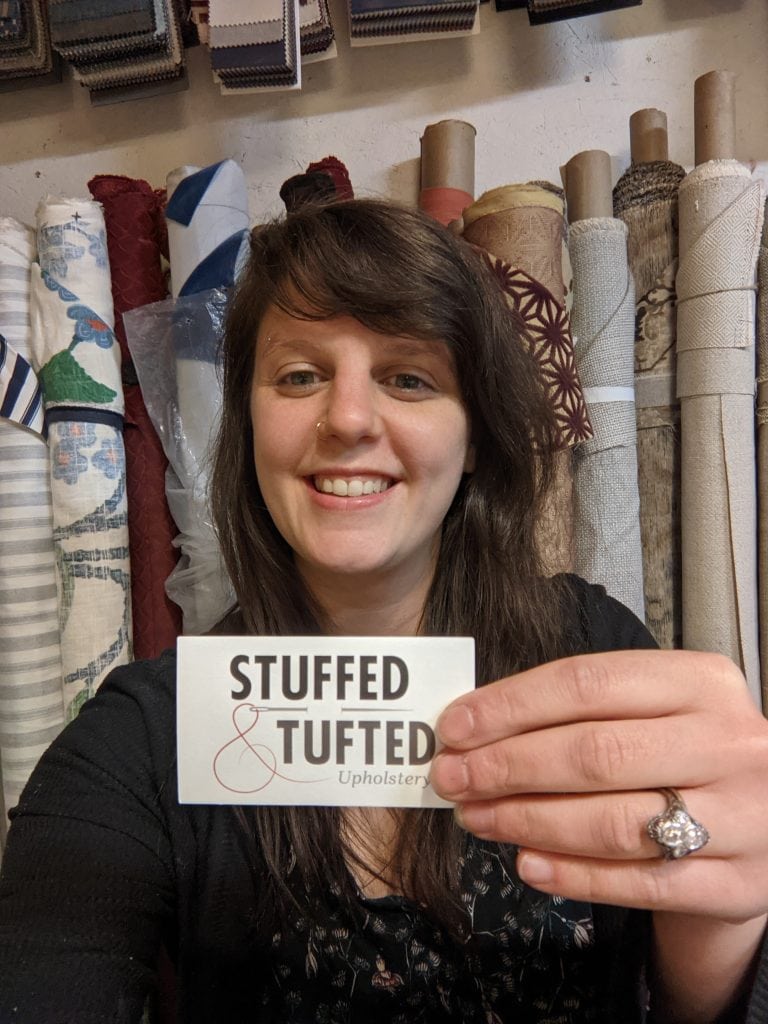
Inspiration Behind Stuffed & Tufted
SBS – What inspired you to start Stuffed & Tufted?
Samantha – My business, Stuffed & Tufted, started as a way to break into the upholstery industry— which I wouldn’t say is the best reason to start a business, but it’s seemed to be working so far! I was in the middle of shifting away from a career in professional theatre production and was eager to find a new calling where I could continue to work with my hands. I had learned the basics of upholstery while working in theatre, and was fascinated by furniture and the upholstery process.
Custom upholstery in the United States has shifted over the years, and the majority of shops are now owner operator businesses. There are larger shops with employees, but the ones in my area are run by older men who weren’t interested in hiring and training a young woman. The only choice seemed to be to dive right in with my own company. I was eager to connect with clients and bring their visions to life.
Developing Upholstery Skills
SBS – How did you develop your skills in upholstery and furniture repair?
Samantha – I learned the very basics of upholstery and furniture repair while working in the props department of a professional theatre — fabric layout and placement, how to use a staple gun, the importance of pattern matching, and communicating with others to fabricate what they’re visualizing. But, as you can imagine, upholstery for the theatre is a bit different than for people’s homes.
Unfortunately, there are currently very few opportunities for full professional upholstery education in the United States, and my skills are widely self-taught. I created an education for myself by scouring books and the internet and by taking furniture apart like a reverse instruction manual on how to put it back together. Each project is a learning opportunity, and most upholsterers will tell you that they’ll never stop learning something new.
I am also very fortunate to have connected with other professional upholsterers online; being able to talk through a task with another upholsterer is quite enlightening. I joined, and am sitting secretary of, the National Upholstery Association, which is a fairly new organization (started in just 2019!) that is working hard to bolster the trade. They provide their members with community meetings and monthly webinars, which has been great for growing my knowledge. There is also a forum on Facebook, the Professional Upholsterer’s Network, where professionals ask each other questions and their opinions on skills and tasks. Being a part of a larger upholstery community has helped me grow my skills just as much as tackling projects.
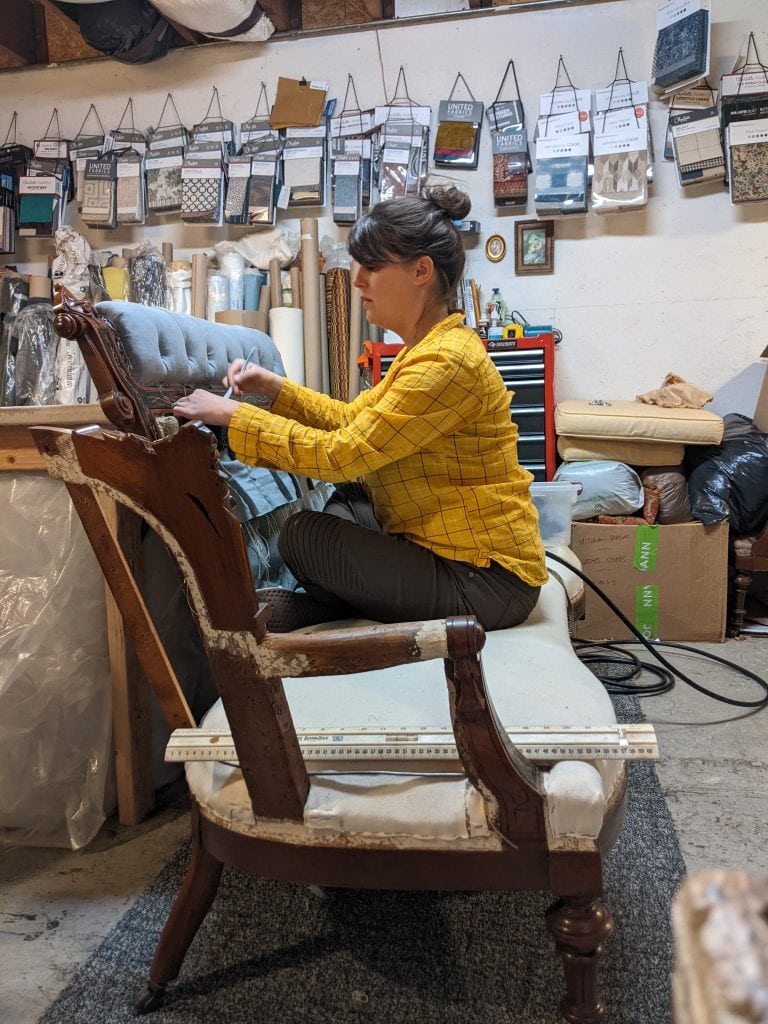
Common Repair Requests
SBS – What are the most common types of furniture repairs or customizations requested by your clients?
Samantha – One of the most common types of furniture repairs I make is to replace the foam in seat cushions. Mass-produced furniture uses the lowest quality materials possible to keep costs low. I will often swap out the foam in my client’s sofa cushions with a higher-grade material, which significantly increases comfort. This is a fairly easy fix to lengthen the life of your living room furniture.
The seating portion of a piece of furniture takes the hardest wear and tear. A more in-depth — but common — repair is to re-tie the seat springs in sofas or chairs. This repair needs to be done in conjunction with a full reupholstery job, as the springs are the foundation of seating. Quality furniture has coil springs in the base that are hand-tied together using twine in an 8-knot system to create a resilient and comfortable base. This process is time consuming and rather rough on the fingers, but is a mark of true craftsmanship.
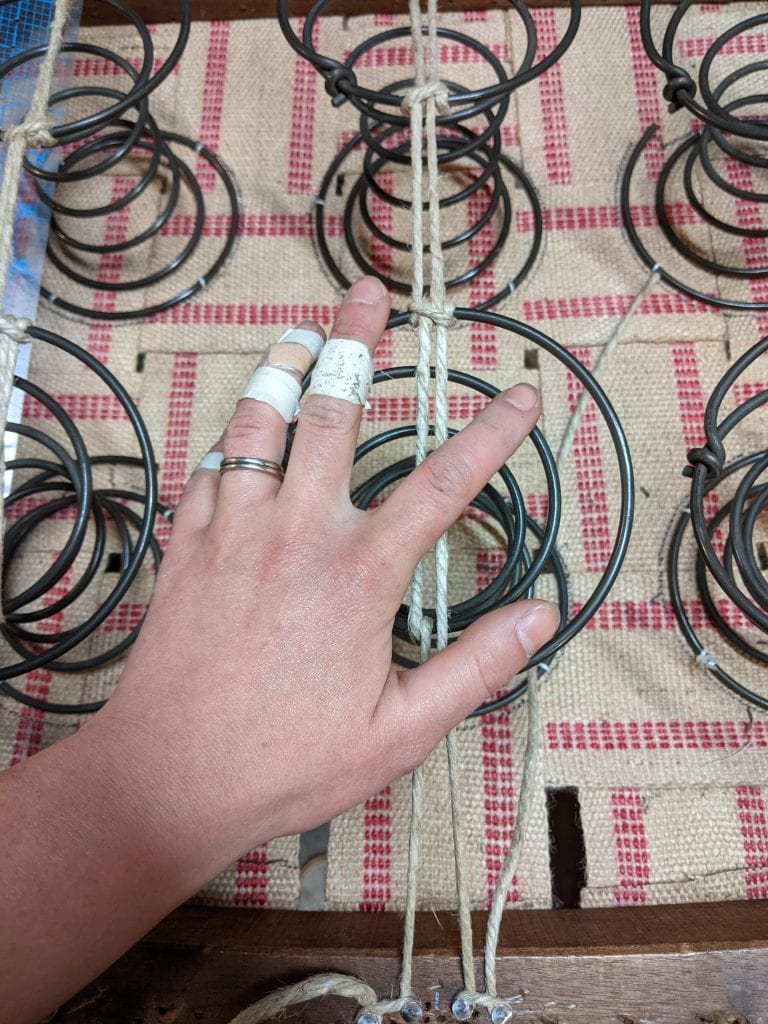
Sourcing Materials
SBS – How do you source materials for your projects, and do you have preferred suppliers?
Samantha – The most well-known material used in upholstery projects is the fabric. There are a limited number of mills that make the fabrics and sell them to reputable fabric distributor companies that only sell to wholesale clients.
I love the fabric companies I work with and deal with fabrics through Charlotte Fabrics, United Fabrics, and leather from Casper Hill Leather. These to-the-trade-only companies make sure that the materials are top-grade and can even track which dye lot you’ve used for a project in case you need to match something very specifically.
Customers will often ask to bring their own materials that they’ve found through third-party sellers for cheap, but the truth is that these fabrics are seconds from mills, are lower quality, and often come with far more flaws. I urge clients to trust the upholsterer in the fabric selection process!
As for the numerous other materials that are overlooked in the upholstery process — thread, staples, glue, trim, cotton or polyester batting, zippers, the list goes on and on — I, of course, have favorite suppliers just like someone has a favorite grocery store. I love to use Rowley Company, Albany Foam and Supply, Tidewater Industries, and Wawak, all for different reasons. I try to make sure that each of the supplies I select is of the highest quality for my clients.
Trends in Upholstery Design
SBS – What trends in upholstery and furniture design have you noticed recently?
Samantha – I personally never focus on what is “in” or trendy, but instead always urge clients to choose styles and colors that they love. This ensures a piece of furniture that will be used for years to come instead of being swapped out when next season’s trends roll in.
That being said, I am very excited to see that more clients are choosing colorful and patterned fabrics! All white and beige furniture is becoming less prominent as the maximalist style is becoming more popular. Bring on the bold colors, big florals, and nubbly textures — and all mixed together!
Marketing Strategies
SBS – How do you market your business and attract new clients?
Samantha – My business is a one-person operation, so I’m not usually looking for a huge influx of clients at once. My best marketing strategy is to have positive client interactions and have people spread the word about me and my business. I encourage them to tell their friends and family about me, and I am shameless in asking clients to leave me a review on my Google business page. I proudly boast 28 five-star reviews! Otherwise, I promote Stuffed & Tufted primarily through social media, typically on Instagram. I post polished final looks of furniture but also show the insides of pieces so clients and potential clients understand how much work really goes into this craft.
Sustainability Focus
SBS – What role does sustainability play in your business model, and how do you promote it to your clients?
Samantha – Though I do sometimes create newly upholstered furniture for furniture designers, my business currently focuses on reupholstery — the act of replacing worn-out materials on a frame. This is in and of itself linked to sustainability, replacing only the parts necessary and keeping an entire piece of furniture from a landfill.
I am always honest with my clients about what needs to be done to their furniture, and I will happily make repairs instead of a full reupholstery job if possible and wanted. There was a loveseat that a client truly loved, but the back had torn during a move. I suggested replacing just the back in a complimentary fabric, and tied it all together with coordinating trim. There was no need to get rid of the parts they loved, and the client couldn’t have been happier with the “new” look of their seating.
I showcase the reupholstery process on my social media, hoping clients and followers will see the care and effort that goes into the craft. The more the public sees and understands upholstery, the more people will choose to have their furniture to be reupholstered. Public understanding is a huge step in the future of upholstery.
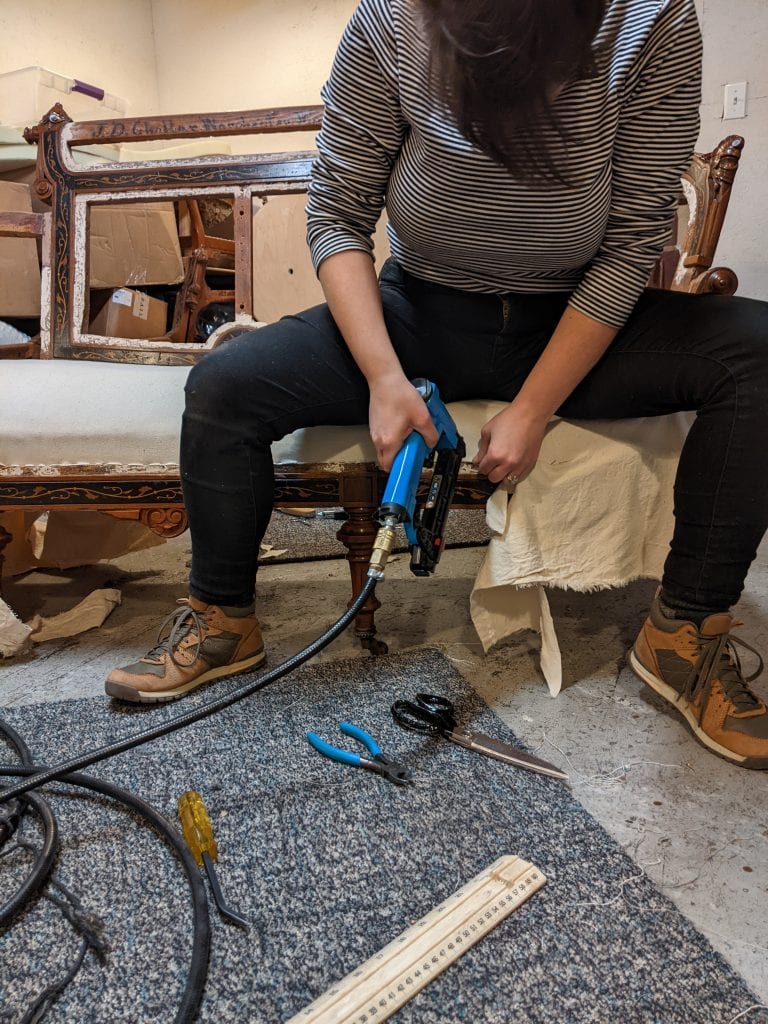
Client Consultation Process
SBS – Can you describe your process for working with clients, from initial consultation to project completion?
Samantha – Whether a client has a small repair or needs a piece of furniture totally made over, the first step is to send me an email. I ask clients to include photos, rough dimensions, and a detailed description of the work they’re interested in getting done. Sometimes it’s helpful to have an in-person meeting to see the furniture, but I can usually provide an estimate based on images. Without X-ray vision, it is impossible to tell what is really going on inside a piece of furniture, similar to a mechanic needing to open up the hood of a car to understand the problem. But I look over the pictures carefully and am very thoughtful about writing my estimates, including a range of costs to reflect possible necessary fixes.
Once a client accepts an estimate, we sign an agreement, I put the project on my schedule, and then we start looking for fabrics. I send them links to my preferred fabric companies, who have great websites with filters to narrow down what they’re looking for. I am happy to help search for fabrics if a client needs guidance. I usually suggest that clients select no more than eight fabrics to choose between and I provide them with free swatches to review in the comfort of their home.
When a fabric has been selected, I’ll collect a 50% deposit of the estimated cost, so I can get materials ordered. I know how inconvenient it is to be without seating in your home, so I try to take pieces only when I am ready to work on them (plus, I have a tiny workshop!). I coordinate when it’s time to get the furniture to my studio, arrange a pickup if wanted, and then I’ll get to work making sure everything is solid and comfortable.
I communicate via email any additional work needed or process shots if requested. Though many clients find it fun to follow the reupholstery process via my social media. Once the project is complete, I send the final invoice and a sneak peek final photo to the clients. I carefully wrap the furniture in drop cloths or plastic and coordinate how it will get back home again. I usually try to follow up with clients a few days later to make sure they’re pleased with their furniture and to ask them to kindly recommend me to their friends and family.
Essential Tools and Equipment
SBS – What are the most important tools and equipment in your workshop, and how do you maintain them?
Samantha – The absolute most important tools in my workshop are my eyes and my hands! They are such an integral part of the process, and without them, I would not be able to perform my trade. I can often see that something is “off” even if I’ve just measured it; I am conscious of wearing eye protection when removing or slinging staples. I also make sure to have plenty of stretch breaks to give my fingers a rest — many upholsterers suffer from arthritis and carpal tunnel.
More traditional tools that are important to the upholstery trade are my sewing machine, staple gun, and air compressor. I use a Juki industrial sewing machine and I make sure it is topped up with oil for smooth stitching and am careful to cover it whenever not in use. I know the basics of sewing machine repair, but am lucky to have a repair shop nearby that I trust with anything I can’t fix myself. I also make sure to regularly oil my staple guns, replace the consumable parts when needed, and have them tucked away in a drawer when not in use. I drain my compressor from collected water regularly to extend its life. There are numerous more hand tools important to the upholstery trade that mostly just need to be nicely taken care of. I always try to clean up my space at the end of a work day, putting away all tools and sweeping up my space for a fresh start the next day.
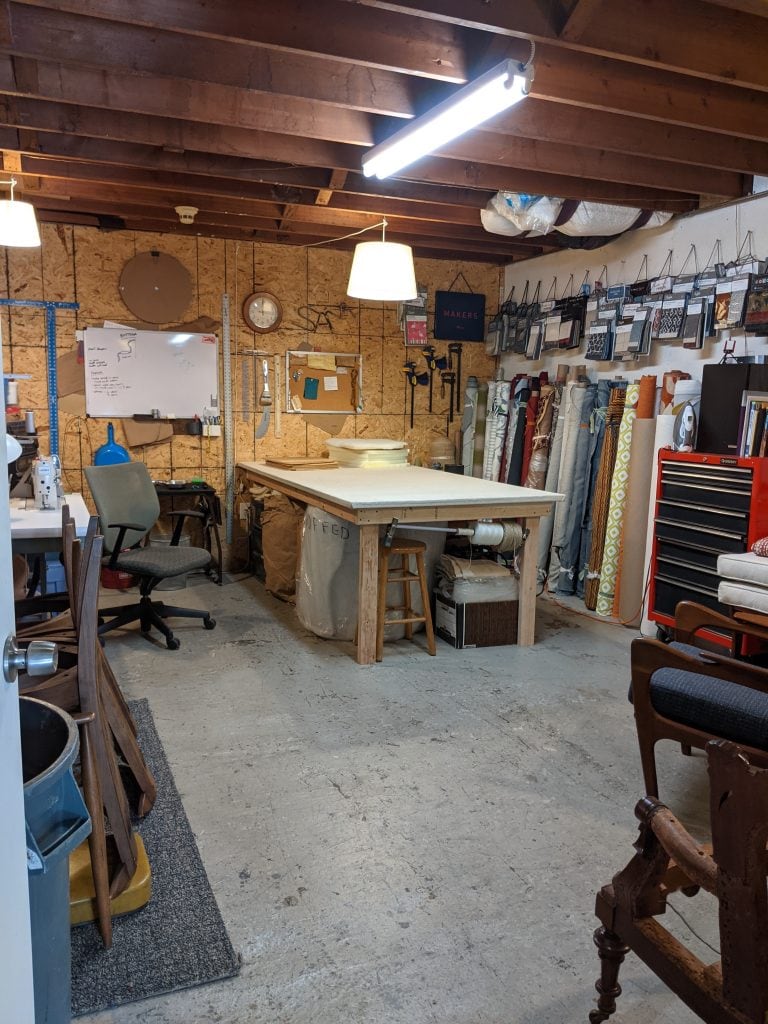
Rewards of Upholstery Business
SBS – What has been the most rewarding aspect of running Stuffed & Tufted?
Samantha – The connection with clients is my favorite part of the job — hearing the story of their furniture or how they will be using it in the future. The most rewarding aspect of running my business is getting to see clients reunited with their furniture. I have had people squeal with delight, jump up and down, and hurriedly plop down in comfort — and I absolutely love all those moments. I always send clients a sneak peek photo before their piece goes home, but it is unmatched to see them see their furniture in person again. I am honored to help people continue to love their furniture.
Future Plans for Stuffed & Tufted
SBS – What future plans or goals do you have for Stuffed & Tufted, and how do you envision the business evolving?
Samantha – Stuffed & Tufted is a fairly young business, but I’ve grown so much in a few short years and am looking forward to more in the future. My current business model focuses primarily on residential reupholstery work. While I never want to leave those clients to the wayside, interfacing with them does take a lot of time, which as a new mom, I’m short on these days.
I am looking forward to growing my relationship with Asé Design Studio, a furniture design studio founded by woodworkers. I collaborate with them to add upholstered elements to their pieces, and it’s so much fun getting to spitball ideas and prototype designs. I also have hopes of forging relationships with local museums to work on their antique furniture. After working on some late 1800s furniture for a private client, I’ve become fascinated with antique furniture. I would welcome the challenge to observe and recreate the techniques used in older upholstery that are not often used in the modern version.
Advice for Aspiring Upholsterers
SBS – What advice would you give to someone looking to start their own custom upholstery business?
Samantha – I would be so excited for anyone who had tried their hand at upholstery and wanted to turn that skill into a business. I would advise them, above all else, to connect with other upholsterers. Being able to share knowledge and ideas with others in the craft would elevate their skills more rapidly than any single project. I would point them in the direction of the National Upholstery Association to find other shops in their area or those with a similar business model. With a strong community, I have confidence that they’d be able to figure the rest out!
Subscribe to Our Newsletter
and gain insider access to cutting-edge business insights and trends.
Featured Resources

Ben Torres on Creating a Whiskey And Cigar Bar In Charlotte, NC
Published on September 2, 2024
Read Now

How Bombay Eats Brings Authentic Indian Cuisine to Chicago
Published on September 2, 2024
Ali Dewjee and his wife Falguni embarked on a flavorful mission 14 years ago when they founded Bombay Eats, originally known as Bombay Wraps. With a ...
Read Now

How MedAssent DDS Supports Dental Medication Management
Published on September 2, 2024
Lauren Fang is a pioneering force in digital health, co-founding MedAssent DDS with a vision to revolutionize dental care. With a deep-rootedconnect ...
Read Now
Comments